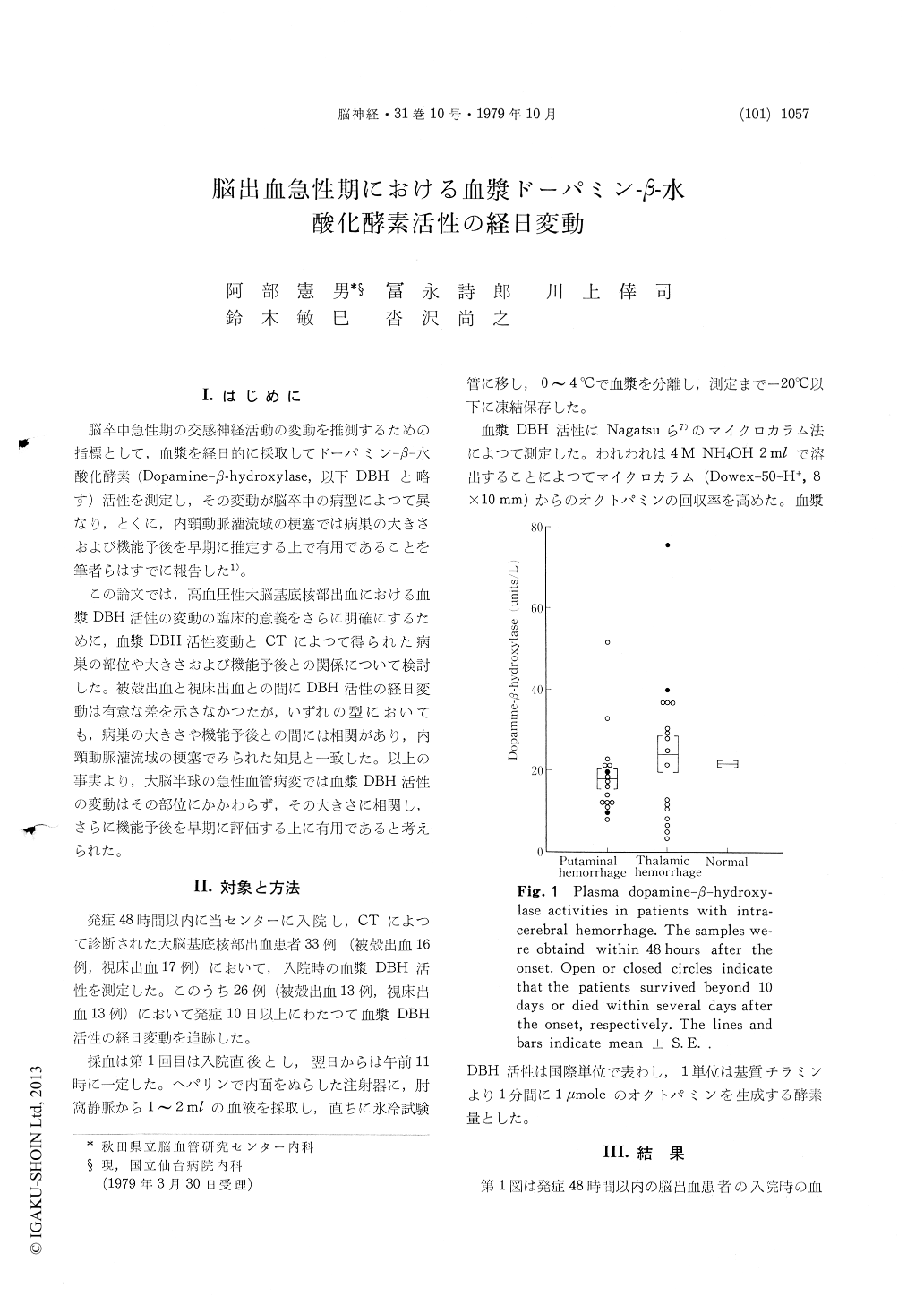Japanese
English
- 有料閲覧
- Abstract 文献概要
- 1ページ目 Look Inside
I.はじめに
脳卒中急性期の交感神経活動の変動を推測するための指標として,血漿を経日的に採取してドーパミン—β—水酸化酵索(Dopamine—β—hydroxylase,以下DBHと略す)活性を測定し,その変動が脳卒中の)病型によつて異なり,とくに,内頸動脈灌流域の梗塞では病巣の大きさおよび機能予後を早期に推定する上で有用であることを筆者らはすでに報告した1)。
この論文では,高血圧性大脳基底核部出血における血漿DBH活性の変動の臨床的意義をさらに明確にするために,血漿DBH活性変動とCTによつて得られた病巣の部位や大きさおよび機能予後との関係について検討した。被殻出血と視床出血との間にDBH活性の経日変動は有意な差を示さなかつたが,いずれの型においても,病巣の大きさや機能予後との間には相関があり,内頸動脈灌流域の梗塞でみられた知見と一致した。以上の事実より,大脳半球の急性血管病変では血漿DBH活性の変動はその部位にかかわらず,その大きさに相関し,さらに機能予後を早期に評価する上に有用であると考えられた。
In 33 patients with intracerebral hemorrhage who were admitted within 48 hours after the onset, the activity of dopamine-β-hydroxylase (DBH) in peripheral venous plasma was analyzed applyingthe method described by Nagatsu and Udenfriend (Clin. Chem., 18: 980-983, 1972) with a minor modification. In 26 patients, the plasma samples were serially collected every a few days for about two to four weeks after the onset.
DBH activity on admission was 18.3±10.8 and 24.1±18.2 (mean±S. D.) units/litter of plasma in patients with putaminal (16 subjects, aged 33~73 years) and thalamic (17 subjects, aged 44~74 years) hemorrhage, respectively. There was no significant difference between the activities in samples collected within 48 hours after the onset between both types of hemorrhage. The activities were not also significantly different from the normal mean activity (20.8±11.7 units/litter, 337 subjects, aged 20~69 years).
The activity within 48 hours after the onset showed the highest value throughout the observ-ation. The activity showed a gradual, time-dependent decline for about 14 days in thalamic hemorrhage, and for about 5 days in putaminal hemorrhage.
The larger the size of hematoma in CT, the worse activities of daily living (ADL) which was evaluated a month after the onset, in both of putaminal (r=0.88, p<0.001) and thalamic (r=0.65, p<0.02) hemorrhages. The patterns of time course of plasma DBH activity after the onset revealed relationships with ADL. In mild cases (ADL1~2), the change in activity was small and tended to recover to the initial value obtained within 48 hours after the onset. On the other hand, severe cases (ADL 4) showed a marked and prolonged de-crease of the activity. In moderate cases (ADL 3), the change was similar to either of both groups mentioned above.
These results suggest that, in cerebral hemor-rhage, its size has a large influence on changes in plasma DBH activity rather than its location.

Copyright © 1979, Igaku-Shoin Ltd. All rights reserved.


